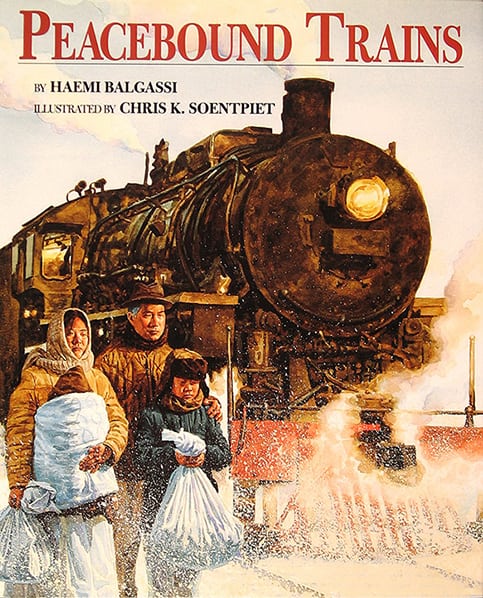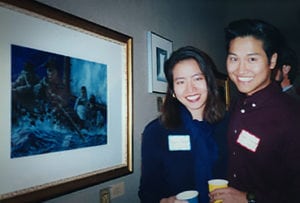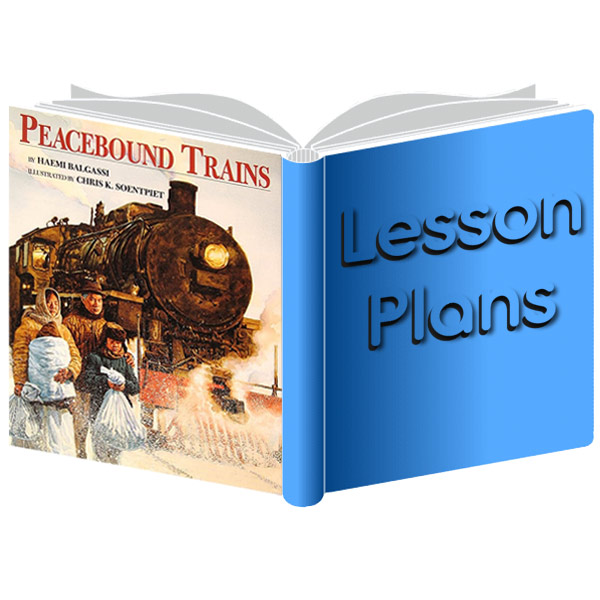 Theme: The children’s book, Peacebound Trains, can be used to introduce your students to the Korean War, refugees, multigenerational families, grandmothers, parents in the military, transportation, geography.
Theme: The children’s book, Peacebound Trains, can be used to introduce your students to the Korean War, refugees, multigenerational families, grandmothers, parents in the military, transportation, geography.
Background: On June 25, 1950 communist troops from North Korea crossed the 38th parallel and invaded South Korea. The 38th parallel was assigned as the demarcation point between North and South Korea at the end of World War II. Troops from 22 countries came together under the banner of the newly created United Nations to fight the communist forces from North Korea, China and the Soviet Union. Many families in South Korea, like the family in the book, were forced to flee to safer places. The fighting between North and South Korea continued until July 27, 1953 when a cease-fire was negotiated but an armistice was never signed. Today, North and South Korea remain divided at the 38th parallel. North Korea is still a communist country and South Korea is a democratic country. American troops still remain in South Korea.
Pre-reading: Show the students the cover of the book, read the title, author and illustrators name. Ask them what they think the book will be about. Next, show the illustration of the modern train – now ask them what they think the book will be about. Ask if anyone has ever ridden on a train. Where did they go? Did the train look more like the one on the cover, or the one inside the book? Was the train crowded? Where did they sit on the train? Set the location of the book and tell the students that this book has a story within a story. Explain that the grandmother will tell a story that happened many years ago. Have the students look at a globe or world map to locate Korea and the United States.
Reading: As you read and show the class the book’s illustrations and have students look closely at them. What details can they find in the pictures? Have them study the expressions on the faces of the characters. How do the character’s expressions change during the story? Ask students how they think the characters are feeling. Can they tell by the illustrations? Don’t forget to ask how they think Sumi’s mother is feeling – even though there are no illustrations of her mother, have the students guss how she is feeling. Have a map near by to show the class how far it is from Seoul to Pusan.
Post-reading: Have the students plan a modern train trip from Seoul to Pusan. Compare and contrast that trip with the trip in the book. Did the class enjoy the ending of the book? Take a survey of the students and then, have them write a new one.
The author uses vivid descriptions of the character’s eyes. Have students find these in the text and then see if they can write some descriptions of their own about a classmate’s eyes or another feature. Example: milk-chocolate eyes; chestnut-brown eyes, sky-blue eyes, frosty pink hair, etc.
Interview: Talk with a Korean War Veteran and write their story. Or, interview a parent, grandparent, or another relative or friend who has moved – write their story.
Geography: Have the students plan a trip across the United States, Canada, Europe, Australia, etc. Ask them to estimate the miles, how long will it take, and write down what will they need to bring – food, clothes, entertainment items, books etc. Also have students discuss and make a list of what they will see along the way – rivers, mountains, lakes, deserts, plains, farms, factories, cities etc.
Locate Korea on a world map. Tell the students that many countries sent troops to fight in the Korean War. Have the students locate the countries on the map. How many continents are represented — list the continents and place the participating countries under the correct continent. Which continent is not represented?
Science: Plan meals for the proposed train trip using the food pyramid. Don’t forget to include snacks and any special foods family members might require.
Discuss farms and farming with the class. Where does our food come from? What is a rice paddy? Try growing a variety of plants and keep a journal of their growth.
In the story, the family had to cross a river with heavy currents. Explore currents and how rivers flow. Do lakes have currents, what other bodies of water have currents?
Social Studies: Spend more time studying the Korean War. Cobblestone magazine has a special edition devoted to the Korean War.
Talk about immigration with your students. Are there any immigrants in the class? Make a list of all the countries the students’ ancestors come from. Do any students have ancestors from a country that fought in the Korean War?
Make a guidebook to Korea and cover topics like cities, geography, customs, traditions, folklore, early history, food, games and traditional dress.
Literature: Read another book about Korea and the Korean War. Some of my favorites are: Dear Juno by Soyung Pak, The Name Jar by Yangsook Choi. Look for other books by Haemi Balgassi or Chris Soentpiet.
Art: Make a life-size paper doll. Have students pick partners. Then ask them to take turns tracing each other on sheets of brown wrapping paper. Then, ask students cut out the tracings and decorate the paper dolls with scraps of paper, fabric, yarn and other craft items – don’t forget magazine pictures.
Make paper dolls to represent the characters in the story or children and adults in traditional Korean dress.
Train graphic organizer – use the modern and old style train cars to list the events of each story. Example: Use the modern engine for the first event in the story about Sumi or use the old style caboose for the last event in the grandmother’s story. Use the boxcars to list the events of the story. Post the trains around the room.
Bulletin Board – Post a “sack” on the Bulletin Board and have each student list what they would pack if the had to leave home suddenly – remember they will have to carry the “sack” so no televisions please!
If you enjoyed reading Peacebound Trains write a review about the book and post it on Amazon.com or Barnesandnoble.com so others can enjoy your reading experience.
Words from the Author, Haemi Balgassi

Author, Haemi Balgassi
My inspiration for this story was a gift from two courageous women: my grandmother and my mother. When I was a young girl, my grandmother shared with me the story of her harrowing rooftop train ride during the first harsh winter of the Korean War. My grandmother passed away when I was eleven, but her story stayed with me. When I was in high school, I asked my mother to tell me what she remembered of that rooftop train ride. My mother added another layer to my grandmother’s story-the memories she’d carried since she rode the train as a five year old. Her sisters, my aunts, also made the trip. I knew then that, one day, I would write a story based on my family’s experience in the Korean War. And a decade later, I did. I titled it PEACEBOUND TRAINS, after the train that has haunted me since my grandmother told me about it all those years. – Haemi Balgassi

Chris and Yin at the Society of Illustrators Awards


